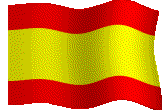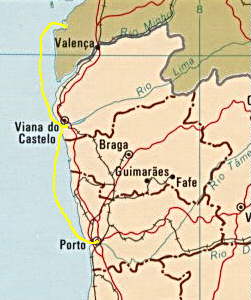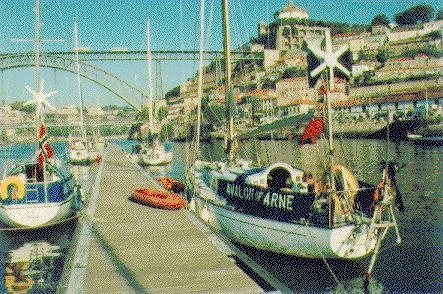Sailing the Atlantic, Cruising the Caribbean - Avalon of Arne
By Phaon Reid


Bayona to Porto
 By the time our new GPS aerial had arrived and been fitted, most of our friends had already set off down the coast. We motored off around the headland, and on south towards the Portuguese border. After a while a gentle breeze sprung up so we hoisted the Cruising Chute and turned off the engine. A school of dolphins paid us a visit, swimming alongside us and zooming under the boat. When the dolphins went, the wind dropped off too, so we motored on down across the border. The wind came and went all day, so the chute was going up and coming down like a yo-yo.
By the time our new GPS aerial had arrived and been fitted, most of our friends had already set off down the coast. We motored off around the headland, and on south towards the Portuguese border. After a while a gentle breeze sprung up so we hoisted the Cruising Chute and turned off the engine. A school of dolphins paid us a visit, swimming alongside us and zooming under the boat. When the dolphins went, the wind dropped off too, so we motored on down across the border. The wind came and went all day, so the chute was going up and coming down like a yo-yo.
At around 6.30 pm we arrived in Viana da Castelo, a fair-sized town with a large Church (slightly reminiscent of Sacre Coeur in Paris) overlooking it on a hill. This can be reached by a funicular railway - or on foot if you’re energetic. Viana is a nice place - it’s one drawback is that you have to moor in the marina; no anchoring is allowed and there are no mooring buoys.
On arriving in the marina our lines were taken by a pleasant English chap who turned out to be David Lumby, the the local representative of the Cruising Association. He is working in Portugal, doing something quite important (I don’t remember exactly what). In his spare time he is extremely helpful to visiting cruising yachts. He presented us with a useful and well-written guide to the Viana area, and told us where to go to clear Customs and Immigration.
This was our first introduction to the notorious Portuguese bureaucracy. Most EU countries take a fairly relaxed attitude to the movement of yachts between member states. Not Portugal. While the officials are generally courteous, they require reams of irrelevant information and they are SLOW. At Viana, the situation had been greatly exacerbated by the recent introduction of a computer system. Not only did the system give the impression of being poorly conceived, but the staff had not the faintest idea how to use it. Occasionally an entry would be rejected, the system would bleep, and the staff would go into a huddle over it, jabbering and gesticulating in Portuguese. Eventually they’d clear the screen and start again from square one. It would have been quicker to engrave the information on stone tablets with a hammer and chisel.
We stayed in Viana for about three days, during which time Dave, the Cruising Association rep, was enormously helpful to us and the other yachties. One evening we all went for a meal together in a typical Portuguese restaurant - eating, among other things, the famous bacalhao or dried salted cod. On another day he arrranged a minibus trip into the hinterland, where many villagers live much as they must have done hundreds of years ago. He also took us to a large supermarket, which was very useful for stocking up. There are some very good tinned meals available in Portugal, and we bought a number of these as they are handy for the longer crossings.
The area around Viana is good for walking, if you’re into that sort of thing. Sarah and I took a long walk one day and ended up getting extremely lost. A kind Portuguese gentleman ended up giving us a lift home in his car. In fact, we found the Portuguese people very friendly and helpful during the whole of our stay - apart from the bureaucrats. We gather that things are a bit different further south in the Algarve, as it is a major package holiday destination.
From Viana we sailed down to Leixoes, a deep water harbour with a Marina just north of the Douro River, on which the city of Porto lies. Leixoes and its Marina are both uninspiring, but there is a regular bus service into Porto from just outside the Marina. The morning after arriving in Leixoes we took the bus into the city and almost immediately after arriving, we bumped into Toby from White Bread. He said that we must bring Avalon upriver into Porto as it is a great city, with a free pontoon in the middle of the river where you can moor in the centre of town. We went down to the River with Toby and went aboard for a few glasses of wine. Wild Rose was there too - Carole had just left to go back to England, so Chris was going to carry on singlehanded for the time being.

After seeing the setup, we agreed that we should bring Avalon up the river, and we did so the next day. The entrance to the Douro is quite tricky, and best done at or just before high water. Not knowing this, we arrived at the entrance just before Low Water, and even with the engine at full power could make no progress against the ebb. We had to drop the anchor and wait an hour or so. Once through the “chicane” by the river mouth, it is a pleasant trip a couple of miles upriver into the town. I believe that the pontoon had been installed for the tall ships race some time previously. I don’t know if it’s still there now. If not, you have to tie up alongside the quay, which is probably a good deal less satisfactory.
We loved Porto and had a great time there. It is a rambling, ramshackle old place in some ways, but has enormous character and charm. Unlike many major European cities, Porto has not been ravaged by war so the town cntre has remined basically unchange for centuries. Needless to say, we visited many of the Port lodges, taking tour around their cellars and sampling their product. An election was taking place during our visit, and each of the two major political parties had comandeered one side of the river. Stages had been erected, and various live music and dance spectatcles took place to entertain the party faithful - and anyone else who happened to be around. The night of the election was like a huge street party, and we all joined in, cheering and clapping and waving banners. At one stage we noticed that some of the locals were looking askance at us - we eventually realised that we were waving the wrong party’s banner for the side of the river we were on! At the end of the evening there were fireworks - not much to look at but exceptionally LOUD.
If you’re heading down the Iberian coast, Porto is a place that you really must visit.


